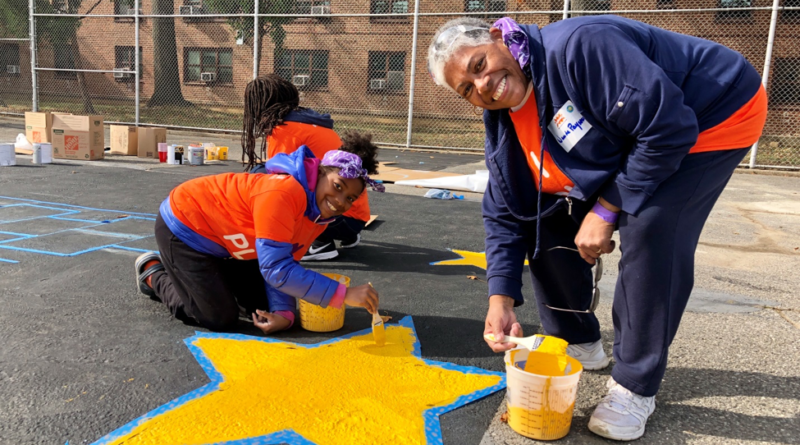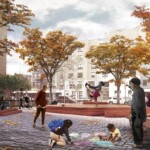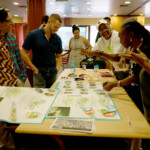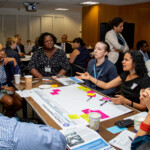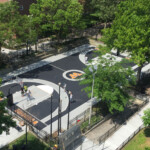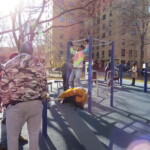NYCHA’s Connected Communities Initiative Wins Wellbeing Cities Award
Dear Colleagues,
We’re excited to present Connected Communities, a powerful NYCHA initiative that prioritizes community-centered urban design for the largest housing authority in North America. Today, NYCHA was named as one of five award-winning laureates from across the world for the 2020 Wellbeing Cities Forum by the New Cities Foundation for our work supporting cohesive communities.
The holistic urban design and community engagement principles outlined in the Connected Communities Guidebook inform how we work with residents and other community partners to improve our public spaces while we renovate and preserve our properties – to ultimately better connect our communities with surrounding neighborhoods.
As a steward of over 2,400 acres across the 5 boroughs of New York City, NYCHA is using design of the public realm to better physically connect our residents to each other, and to surrounding neighborhoods and resources.
In the past year, we’ve launched a host of bold strategies to rethink, recapitalize, and transform the Authority, and to fundamentally rebuild our business operations so we can better serve our residents. Connected Communities is an important part of this work and central to our efforts to holistically improve every development in our portfolio, and how we support residents. The initiative leverages public-private partnerships to enhance our residents’ quality of life through improvements to NYCHA’s outdoor spaces. That includes enhancements such as fitness areas, artwork installations, and climate resiliency infrastructure.
The wellbeing of NYCHA families is our top priority, and we are eager to increase public safety, boost residents’ mental and physical health, and strengthen social cohesion in our neighborhoods. In light of the COVID-19 pandemic, this work to provide our residents with healthy homes and open spaces – so that they can thrive where they live – is more critical than ever.
Please take a look at our Connected Communities Guidebook, which is available on NYCHA’s website. We brought together urban design leaders to develop it, and it outlines how we promote New Yorkers’ wellbeing through effective design strategies, planning, and partnerships.
We want the resident experience to be the top priority as we reimagine and redesign these spaces. We’re capitalizing on all the great resources available in New York City, and the amazing partners like the NYC Department of City Planning, Mayor’s Office of Community Justice, Parks Department, climate and design advocates, and others.
We’ve already brought millions of dollars in investment so far, in projects that are helping elevate the quality of life for our residents, and we hope to continue making progress for our residents and for New York City.
We look forward to working together to continue making our city a better, healthier place to live. This is just the beginning.
Thank you,
Greg Russ, Chair &Chief Executive Officer
In the photo above, residents build a playground in partnership with KaBOOM! at Pomonok Houses in 2017.
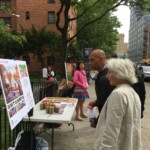
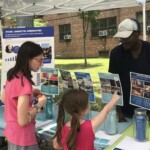
Connected Communities highlights several completed or in-progress community projects that were realized in concert with other City agencies that focus on issues ranging from improving social cohesion to increasing a sense of public safety. Some notable examples include:
- Opening the Edge: A partnership between NYCHA and the Design Trust for Public Space at Lillian Wald Houses in the Lower East Side aimed at connecting public housing residents to the surrounding community through community-designed art, performance spaces, and multi-lingual signage acknowledging the diversity of the NYCHA campus.
- Neighborhood Activation Projects: A partnership between NYCHA, the Mayor’s Office of Criminal Justice (MOCJ), and the Center for Court Innovation that helps activate open space in 15 Mayor’s Action Plan sites targeted for neighborhood safety. Residents have implemented gardens, murals, and youth-centered programming to increase activity in open spaces.
- Red Hook Farms: A collaboration between NYCHA and the nonprofit organization Green City Force that resulted in the creation of a 1.1-acre educational farm. A 2019 CUNY study found that 80 percent of NYCHA young adults who participated in the work-training program at Red Hook Farms were successful in job and college placement.
- Cloudburst Resiliency at South Jamaica Houses: A planning program developed in coordination with the NYC Department of Environmental Planning that is the first placemaking green infrastructure project at a NYCHA campus. The project will eventually result in the first publicly funded submerged water plaza in Queens, as well as retention tanks under area basketball courts aimed at mitigating flooding.

